Abstract
Escherichia coli that carry a recombinant plasmid bearing the Vibrio fischeri lux regulon express luminescence that mimics the luminescence of V. fischeri. The lux regulon consists of two divergently transcribed operons, the rightward operon (luxICDABE genes) and the leftward operon (luxR gene). The luxR and luxI genes and the control region separating the two operons supply the primary regulatory control over the lux regulon; the regulatory mechanisms result in a dramatic increase in the rate of luciferase synthesis after induction, apparently due to a unique autoregulatory positive feedback mechanism, and in an enormous difference (greater than 10(4] in levels of luminescence in cells before and after induction. The generally accepted model of primary regulation of bioluminescence in V. fischeri involves the interaction of the product of the luxR gene and N-(3-oxohexanoyl)homoserine lactone, the autoinducer produced by the enzyme encoded by luxI, the first gene of the rightward operon, with an operator sequence within the control region to stimulate transcription of the rightward operon in a positive feedback loop. We have used deletion mapping of a transcription reporter vector to determine the approximate location of the operator. By site-directed mutagenesis of the presumed operator, we have demonstrated that the 20-base-pair inverted repeat ACCTGTAGGA/TCGTA CAGGT (where the vertical line is the center of symmetry), which bears striking similarity to the recognition sequence for the pleiotropic repressor protein LexA, is the operator of the lux regulon. We also found that deletion of sequences upstream of the palindrome leads to increased transcription from the rightward promoter (PR), indicative of a cis-acting element that represses transcription in the absence of the LuxR-autoinducer complex. Modifications of the palindrome that eliminate stimulation by LuxR-autoinducer of transcription from PR have no effect on repression by the cis-acting mechanism(s), suggesting that the palindrome is not necessary for repression of the rightward operon. Thus, it appears that the large increase in transcription upon induction of the lux regulon is the result of at least two independent mechanisms, one positive and the other negative.
Full text
PDF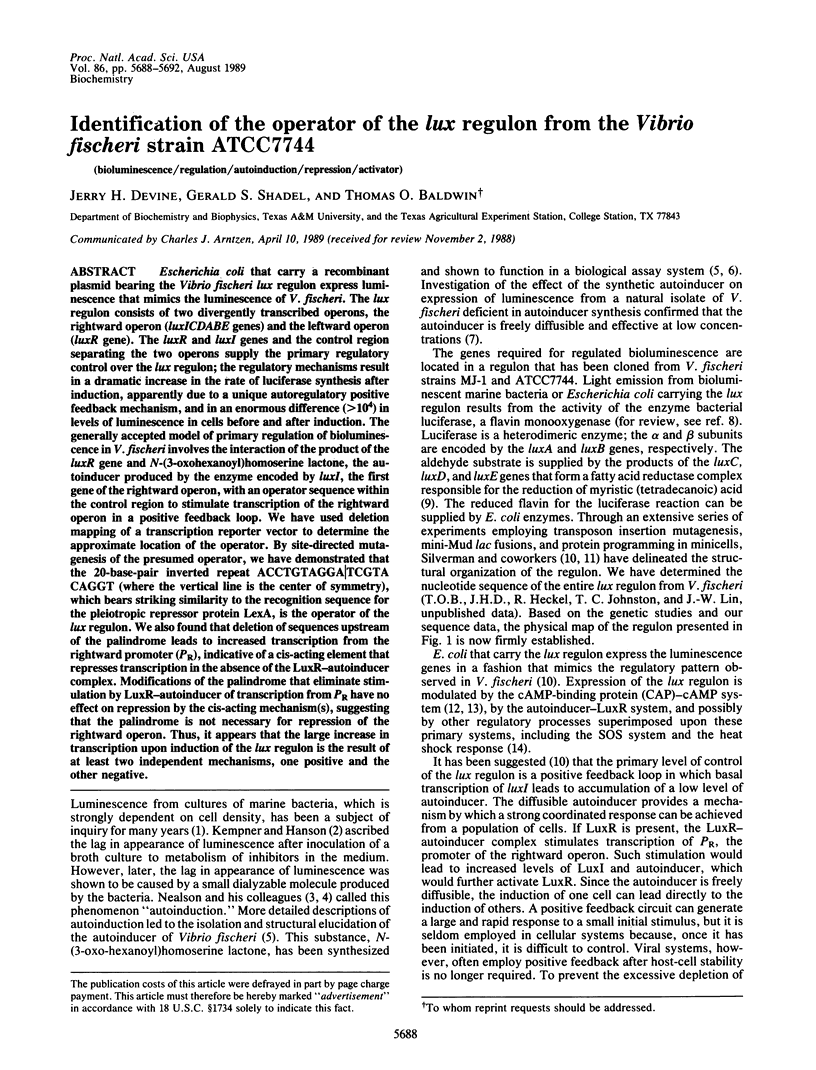
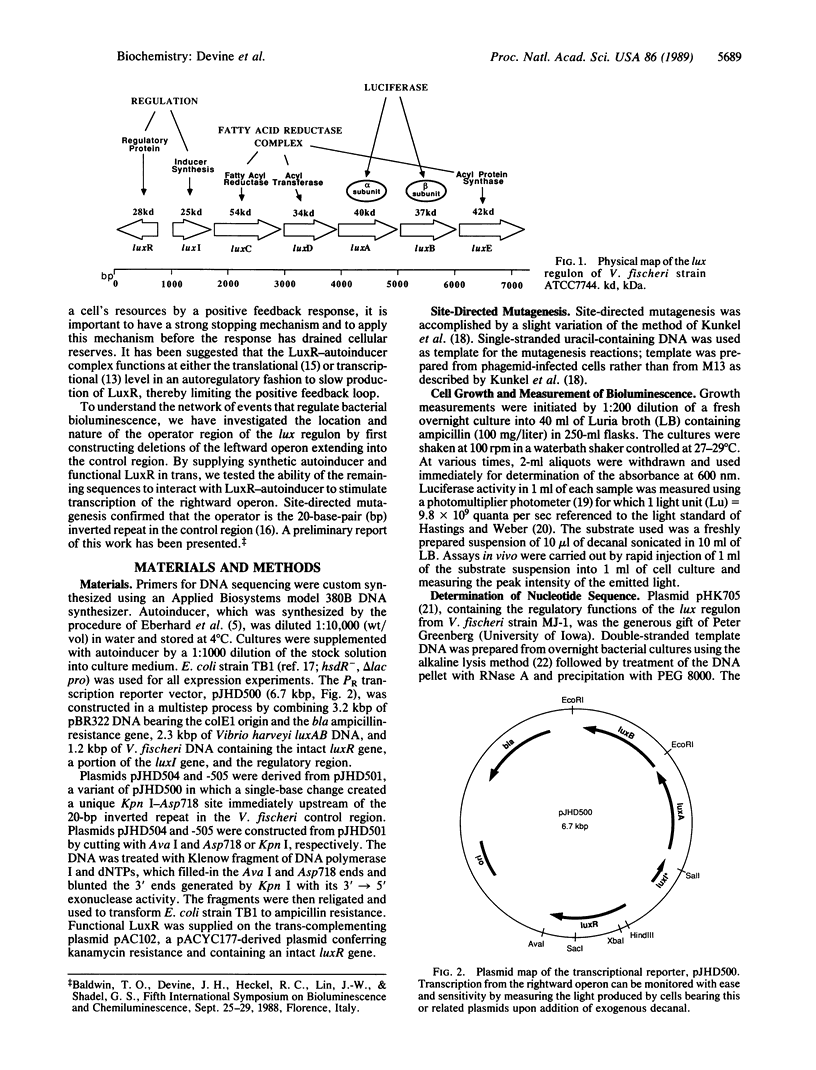
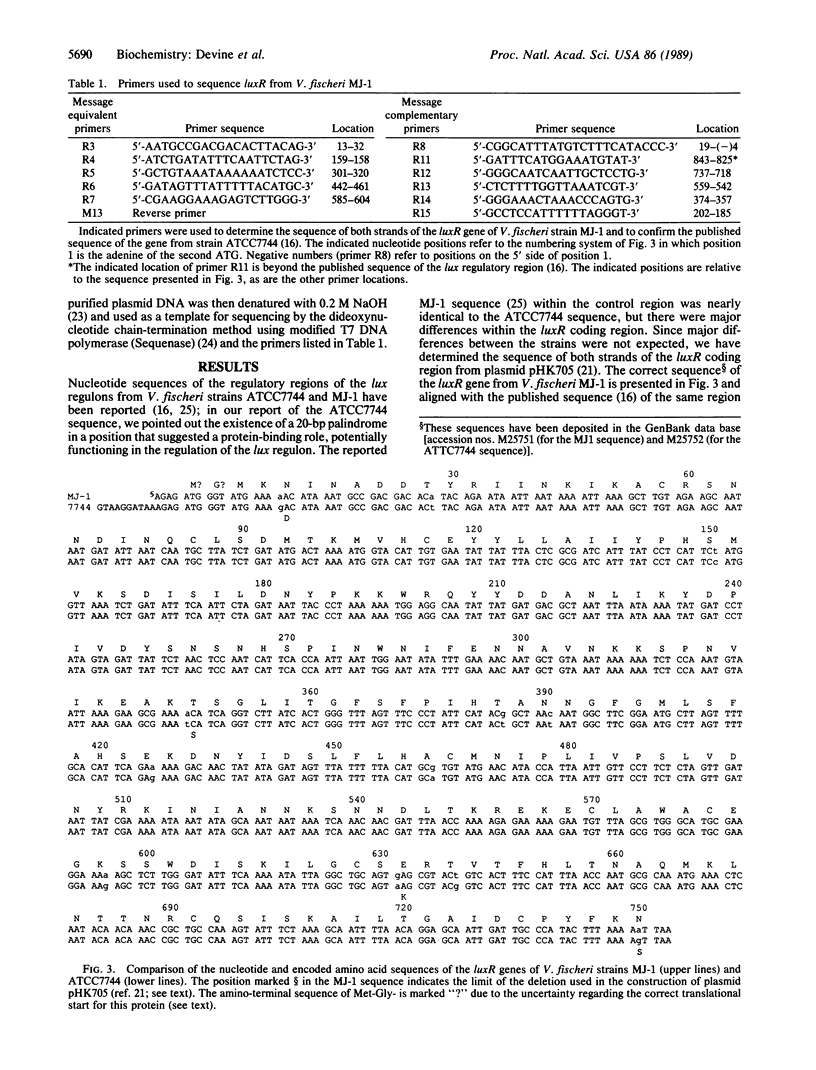
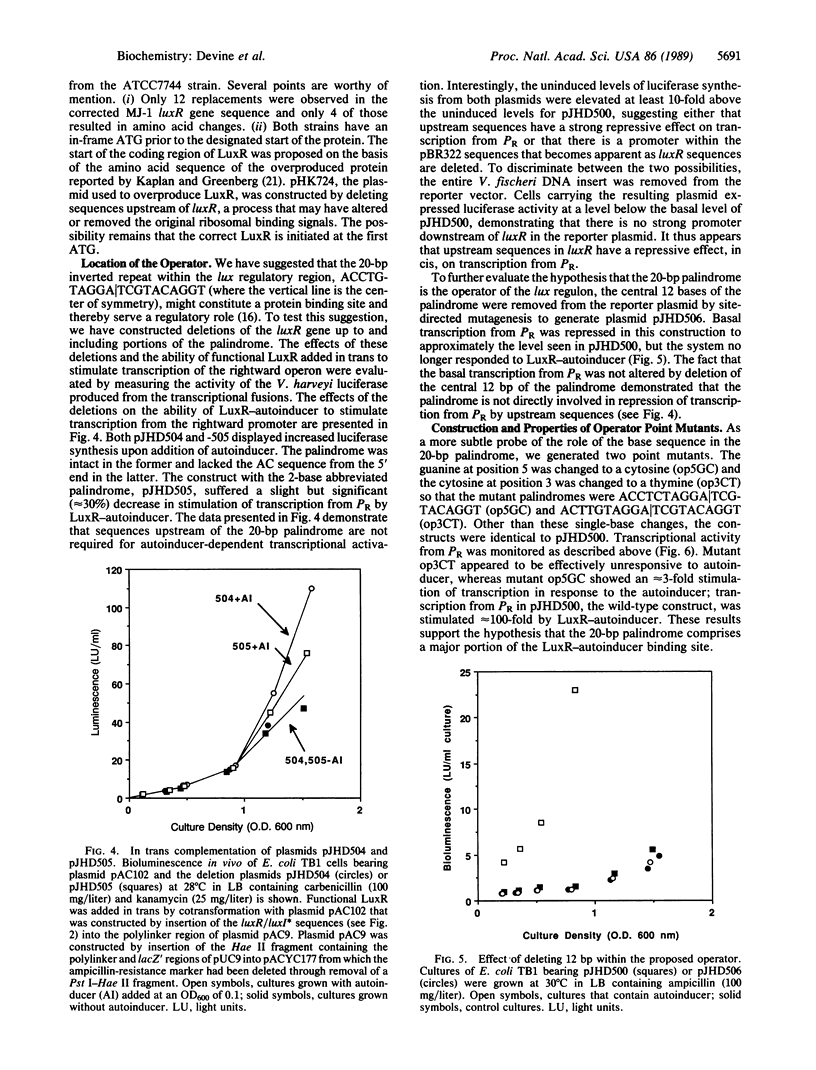
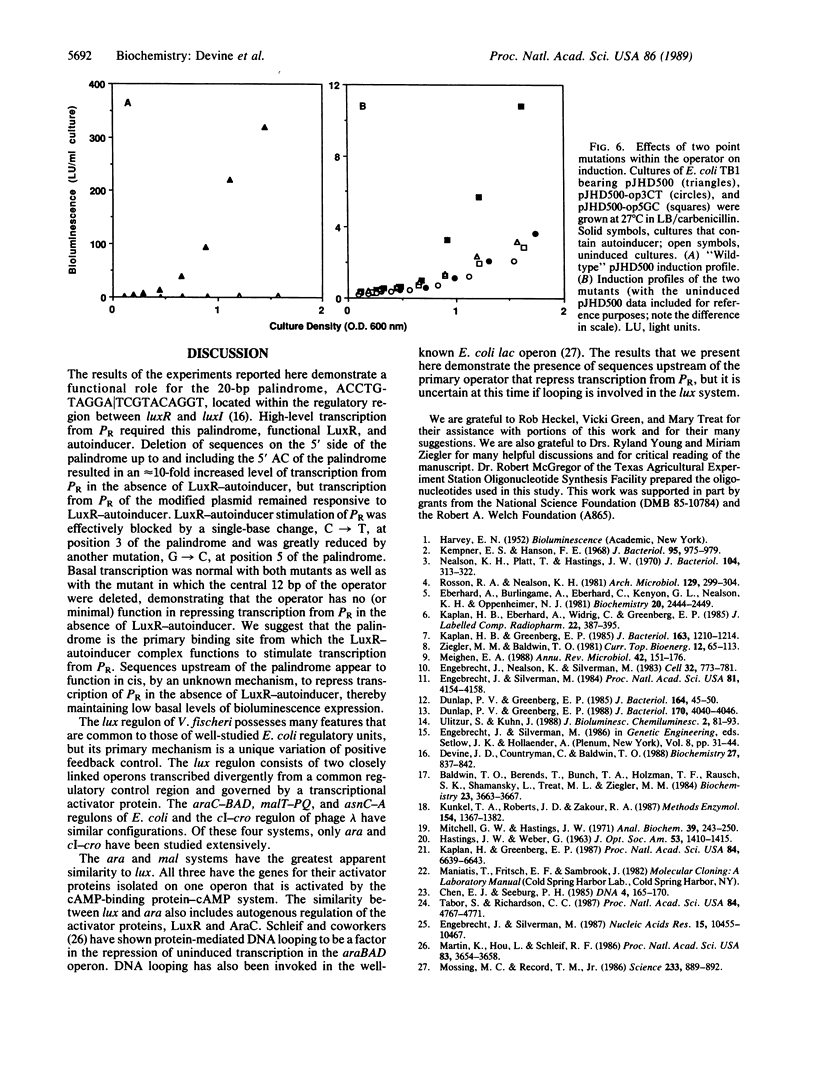
Selected References
These references are in PubMed. This may not be the complete list of references from this article.
- Baldwin T. O., Berends T., Bunch T. A., Holzman T. F., Rausch S. K., Shamansky L., Treat M. L., Ziegler M. M. Cloning of the luciferase structural genes from Vibrio harveyi and expression of bioluminescence in Escherichia coli. Biochemistry. 1984 Jul 31;23(16):3663–3667. doi: 10.1021/bi00311a014. [DOI] [PubMed] [Google Scholar]
- Chen E. Y., Seeburg P. H. Supercoil sequencing: a fast and simple method for sequencing plasmid DNA. DNA. 1985 Apr;4(2):165–170. doi: 10.1089/dna.1985.4.165. [DOI] [PubMed] [Google Scholar]
- Dunlap P. V., Greenberg E. P. Control of Vibrio fischeri luminescence gene expression in Escherichia coli by cyclic AMP and cyclic AMP receptor protein. J Bacteriol. 1985 Oct;164(1):45–50. doi: 10.1128/jb.164.1.45-50.1985. [DOI] [PMC free article] [PubMed] [Google Scholar]
- Dunlap P. V., Greenberg E. P. Control of Vibrio fischeri lux gene transcription by a cyclic AMP receptor protein-luxR protein regulatory circuit. J Bacteriol. 1988 Sep;170(9):4040–4046. doi: 10.1128/jb.170.9.4040-4046.1988. [DOI] [PMC free article] [PubMed] [Google Scholar]
- Eberhard A., Burlingame A. L., Eberhard C., Kenyon G. L., Nealson K. H., Oppenheimer N. J. Structural identification of autoinducer of Photobacterium fischeri luciferase. Biochemistry. 1981 Apr 28;20(9):2444–2449. doi: 10.1021/bi00512a013. [DOI] [PubMed] [Google Scholar]
- Engebrecht J., Nealson K., Silverman M. Bacterial bioluminescence: isolation and genetic analysis of functions from Vibrio fischeri. Cell. 1983 Mar;32(3):773–781. doi: 10.1016/0092-8674(83)90063-6. [DOI] [PubMed] [Google Scholar]
- Engebrecht J., Silverman M. Identification of genes and gene products necessary for bacterial bioluminescence. Proc Natl Acad Sci U S A. 1984 Jul;81(13):4154–4158. doi: 10.1073/pnas.81.13.4154. [DOI] [PMC free article] [PubMed] [Google Scholar]
- Engebrecht J., Silverman M. Nucleotide sequence of the regulatory locus controlling expression of bacterial genes for bioluminescence. Nucleic Acids Res. 1987 Dec 23;15(24):10455–10467. doi: 10.1093/nar/15.24.10455. [DOI] [PMC free article] [PubMed] [Google Scholar]
- Kaplan H. B., Greenberg E. P. Diffusion of autoinducer is involved in regulation of the Vibrio fischeri luminescence system. J Bacteriol. 1985 Sep;163(3):1210–1214. doi: 10.1128/jb.163.3.1210-1214.1985. [DOI] [PMC free article] [PubMed] [Google Scholar]
- Kaplan H. B., Greenberg E. P. Overproduction and purification of the luxR gene product: Transcriptional activator of the Vibrio fischeri luminescence system. Proc Natl Acad Sci U S A. 1987 Oct;84(19):6639–6643. doi: 10.1073/pnas.84.19.6639. [DOI] [PMC free article] [PubMed] [Google Scholar]
- Kempner E. S., Hanson F. E. Aspects of light production by Photobacterium fischeri. J Bacteriol. 1968 Mar;95(3):975–979. doi: 10.1128/jb.95.3.975-979.1968. [DOI] [PMC free article] [PubMed] [Google Scholar]
- Martin K., Huo L., Schleif R. F. The DNA loop model for ara repression: AraC protein occupies the proposed loop sites in vivo and repression-negative mutations lie in these same sites. Proc Natl Acad Sci U S A. 1986 Jun;83(11):3654–3658. doi: 10.1073/pnas.83.11.3654. [DOI] [PMC free article] [PubMed] [Google Scholar]
- Mitchell G. W., Hastings J. W. A stable, inexpensive, solid-state photomultiplier photometer. Anal Biochem. 1971 Jan;39(1):243–250. doi: 10.1016/0003-2697(71)90481-7. [DOI] [PubMed] [Google Scholar]
- Mossing M. C., Record M. T., Jr Upstream operators enhance repression of the lac promoter. Science. 1986 Aug 22;233(4766):889–892. doi: 10.1126/science.3090685. [DOI] [PubMed] [Google Scholar]
- Nealson K. H., Platt T., Hastings J. W. Cellular control of the synthesis and activity of the bacterial luminescent system. J Bacteriol. 1970 Oct;104(1):313–322. doi: 10.1128/jb.104.1.313-322.1970. [DOI] [PMC free article] [PubMed] [Google Scholar]
- Tabor S., Richardson C. C. DNA sequence analysis with a modified bacteriophage T7 DNA polymerase. Proc Natl Acad Sci U S A. 1987 Jul;84(14):4767–4771. doi: 10.1073/pnas.84.14.4767. [DOI] [PMC free article] [PubMed] [Google Scholar]
- Ulitzur S., Kuhn J. The transcription of bacterial luminescence is regulated by sigma 32. J Biolumin Chemilumin. 1988 Apr-Jun;2(2):81–93. doi: 10.1002/bio.1170020205. [DOI] [PubMed] [Google Scholar]


